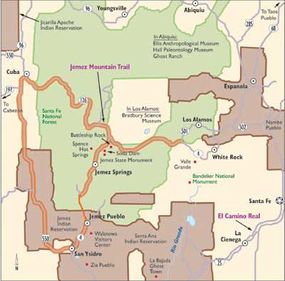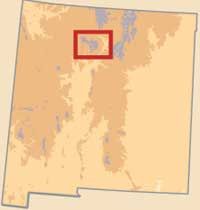The Jemez (pronounced HAY-mez or HAY-mus) Mountain Trail is begins north of Albuquerque, near the unspoiled village of San Ysidro. San Ysidro is a village where you can find the work of local artisans and view the restored Spanish adobe church.
Cultural Qualities of the Jemez Mountain Trail
The greater Santa Fe area is extremely culturally diverse due to strong Native American and Spanish influences. Of the 19 Native American communities located in New Mexico, eight are in the greater Santa Fe area. All eight are Pueblo Indian nations, and their communities are referred to as pueblos.
Advertisement
Many of these pueblos were established centuries ago; the Taos Pueblo, for example, is thought to have been continuously occupied for close to 1,000 years. Each pueblo has its own government, traditions, and ceremonies and is a sovereign and separate entity. The pueblos typically welcome visitors, especially during specific dances and feast days.
A people of great faith, the early Spanish settlers arrived in 1607 with scores of Catholic priests. Just as the Spanish created houses of worship from an adobe mix of mud and straw, they built villages and towns in the same architectural fashion.
Like adobe architecture, art forms practiced by early Spanish settlers were shaped largely from resources they found in their natural environment. Using native aspen and pine, paints derived from natural pigments, and other local materials, they created utilitarian goods and religious objects to adorn their homes and churches.
At first, the work echoed the traditional artworks and motifs they had carried with them to the New World from Mexico and Spain. But in time, native artisans developed styles and techniques that were unique to New Mexico alone. Ranging from santos (carved images of saints), furniture, and textiles to works in tin, iron, silver, and straw, the art of the Spanish colonial era remains the art of many Santa Fe-area families.
Meanwhile, other artists have carried their ancestors' legacy to new levels of excellence by working in more modern media, including sculpture, photography, painting, jewelry, and literature.
Historical Qualities of the Jemez Mountain Trail
Jemez State Monument and Bandelier National Monument are popular places to discover more about the history of the area. Both monuments have exhibits and self-and ranger-guided tours.
Natural Qualities of the Jemez Mountain Trail
You'll find many wonders along the Jemez Mountain Trail. For example, the history of the Jemez Mountains goes back one million years to a volcano's eruption. The eruption created an area of mountains, mesas, and canyons the size of a small eastern state.
Dominating the western half of the Santa Fe National Forest, the Jemez Mountains resemble a wagon wheel on a topographic map. The hub is formed by the giant Valles Caldera (a crater created by the volcano's violent explosion), and the spokes are made by the mesas built of volcanic tuft. Elevations in the range from 6,000 to 11,000 feet. One of the legacies of the volcano is the canyons' Swiss cheeselike rock cliffs and strange cone-shaped tent rocks.
The towering volcanic plug of Cabezon (meaning big head) is famous in Navajo folklore. The volcano has a trail leading to its 8,000-foot summit. In addition, one mile north of the Jemez State Monument at Soda Dam is an unusual geological formation where, over thousands of years, minerals from a natural spring have created a dam that blocks the Jemez River. The river pours through a hole in the dam, forming a waterfall. Soda Dam has become one of the most popular swimming holes in the Jemez Mountains.
Also along the byway is Battleship Rock, a sheer cliff that rises suddenly above the river like the prow of a ship. A few miles past Battleship Rock is the parking lot for Spence Hot Springs, an accessible and scenic place for a long soak in hot mineral waters.

Recreational Qualities of the Jemez Mountain Trail
The Jemez Mountain Trail offers all sorts of outdoor recreation. Travelers enjoy hiking trails of varying degrees of difficulty, biking trails, fishing, and several camping locations. The unique geological features also allow for outdoor adventures; you can visit caves and tunnels.
For the adventurous, Battleship Rock in the Jemez Mountains provides challenging terrain and an intriguing landscape: The trail is covered in shiny black obsidian created from volcanic eruptions five million years ago.
If you enjoy biking, the Jemez Mountain Trail provides several trails. Advanced bikers may want to explore Guacamalla and Paliza Canyons, a steep terrain that offers excellent views of green meadows.
Before you journey onto this trail, take a look at the next page for a suggested tour.
Find more useful information related to New Mexico's Jemez Mountain Trail:
- New Mexico Scenic Drives: The Jemez Mountain Trail is just one of the scenic byways in New Mexico. Check out the others.
- How to Drive Economically: Fuel economy is a major concern when you're on a driving trip. Learn how to get better gas mileage.
Advertisement
